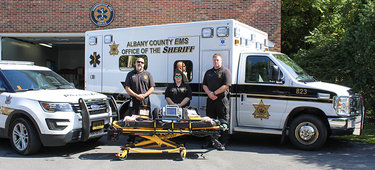EMS district dead in the water
Enterprise file photo — Michael Koff
Plans to fund the Albany County Sheriff's emergency medical services for local municipalities through a county-administered special district have fallen through after the county allegedly said that it wouldn't be able to bear the cost any better than municipalities can.
ALBANY COUNTY — Emergency medical service expenses will be staying within local budgets since an effort to move them over to the county budget has fallen apart.
New Scotland Supervisor Doug LaGrange, who had gathered support from a number of other town and village leaders — including those from each of the Hilltowns as well as Voorheesville — told The Enterprise this week that Albany County’s budget department wouldn’t go for the idea, and that there’s no plan B as of yet.
“I was quite surprised, of course, but I guess they have to do what they have to do too,” he said.
County spokeswoman Mary Rozak told The Enterprise that she wouldn’t be able to provide comment until later in the month since “the people who can talk about this or brief me are in the thick of budget work.”
The gist of the plan was to create a special district that covered the various municipalities currently relying on the county sheriff's EMS services so that the county could directly tax the residents for those services, rather than make each municipality incorporate the expense into its own budget and tax levy. Towns, villages, and even the county all have a levy limit set by the state, which is politically difficult to override.
The current setup doesn’t work well for the towns since, with their smaller budgets, they’re more likely to have to go over the cap — generally around 2 percent — than the county would be, LaGrange said, adding that the county has argued that it, too, would be at risk of having to pierce its cap.
And even though it’s possible to override the cap with a supermajority board vote, that move risks pushback on Election Day, LaGrange said, making it an unpopular move all around.
Last year, the cost for county EMS went up drastically — 30 percent for both New Scotland and Westerlo — as costs for providing the service have increased and Sheriff Craig Apple is trying to make the positions more attractive so as to ensure adequate staffing.
Municipal leaders have been supportive of the cost increases, recognizing the difficult position that EMS workers are in and the necessity of the service, but still worry about how it will affect their own budgets.
“It’s obviously something that had to be done,” LaGrange said this week, “but it’s tough for me, at least … to slide in a 30-percent increase.”
He said this week, as Westerlo Supervisor Matthew Kryzak said last year, that he would have preferred a more gradual increase.
This year, LaGrange said the increase is more palatable at around 6 percent, but that over the past five years, the cost increase is still in the “very high double-digits.”
He said that part of the problem is the increasing requirements the state and federal government are establishing for EMS and other first-response workers, whether they’re paid or volunteer.
The Enterprise reported in July on firefighters’ pushback on proposed Department of Labor’s Occupational Safety and Health Administration (OSHA) requirements, partly due to the huge increase in costs it would put onto volunteer companies.
Volunteer EMS has been vanishing from The Enterprise coverage area over the last decade, due to thinning ranks. The most recent to shutter was the Altamont Rescue Squad on Jan. 1 this year, when it officially stopped providing ambulance services to Altamont and Knox.
“It’s almost to the point where a person that has a regular job and is trying to volunteer in that aspect of emergency services just can’t do it,” LaGrange said.
Unlike Guilderland, which has its own ambulance service, the Hilltowns and New Scotland must rely on either private EMS companies or the county, both of which are still subject to cost-raising regulations.
On how his town will cope with the loss of the EMS district plan, besides smart budgeting, LaGrange said it’s unclear whether there might be an alternative path forward.
“I just don’t have an answer right now because of the county’s reluctance to take this on now,” he said.



